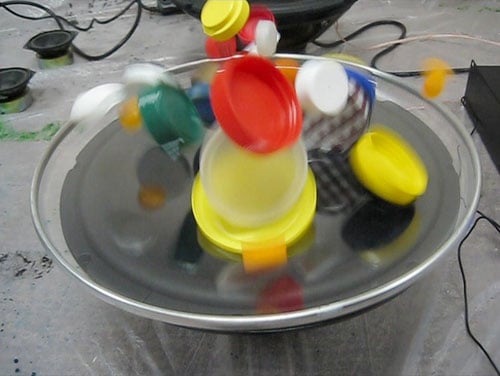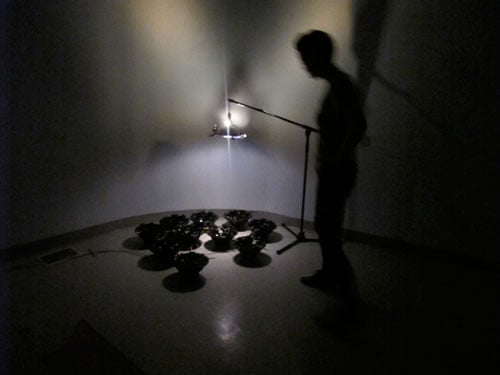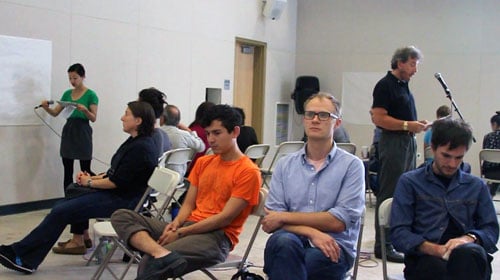Christine Sun Kim
By:
February 14, 2012
I love creating feedback — it’s one of my favorite sounds.

The concept of limitation is embedded in art, as well as in us. All artists work within limitations, some self-imposed (a black-and-white film; stencils on city streets), and others imposed from without (money; access to materials). Often, awareness of a limitation can force the focus and the exploration into something deeper, faster; embracing a limitation can paradoxically channel a barrier breach. So it is with sound artist Christine Sun Kim. Born deaf, Kim has decided to use her practice to reclaim sound on her terms.
[Christine Sun Kim, A Selby Film, by Todd Selby, 2011]
There’s nothing grim at all about something that could be understandably tragic. Her work is playful, exuberant, and wide-ranging, delighting in glial leaps as she connects the attributes of sound to painting, performance, dance, and social constructions.
What is sound to you?
Two things: ghost and currency. It’s there, but I don’t see it (well, unless it’s Slimer). And I am aware how much value the society put in sound, music, and vocal languages. It’s a lot more interesting to explore a medium that I don’t have direct access to and yet has the most direct connection to society at large.
— from the Nowness interview, Nov. 9, 2011
What are the components of sound? Vibrations in a certain frequency range. Music. Noise. Movement. Communication; meaning. Rhythm, timbre, frequency, clarity. Something subtle enough to surround us constantly without our noticing, yet powerful enough to organize space with a single, well-aimed blast: This, Is A Test…
[Christine Sun Kim, Sound Translation, 2009]
Kim plays with all of these variants. She cannot hear a bass note. But she can feel it, and she can use its amplified vibrations to bounce tacks, or plastic bottle lids, on top of a speaker’s membrane. A dance. Or, by dipping an item in paint, she might use the vibrations as paint, with bottlecaps, tacks, or other materials acting as brush, leaving traces that resonate with influences ranging from Abstract Expressionism to the obscure cultural record of cave paintings.

[Christine Sun Kim, Car Window Wind, Upstate New York, 2010]
As part of my practice, I approach sound by constantly pushing it to a different level of physicality. I challenge and question its visual absence and tactile presence. Using my conceptual judgement, I recorded the half-rolled down car window and used the sound of the wind to weakly “blow” the pinwheels, through all the electronics and equipment: television, microphone, mixer, amplifier, microphone stand, light, and pinwheels.
And it’s not just the machines that spark her interest. Sound as speech, as social currency, is as keenly registered in its absence as well as its presence. In Call Your Vocal Authorities (2011), Kim arranged participants in a circle, facing out, and assigned them various texts to read, in sequence, thus externalizing communication from the individual to the group, yet relating it to her excluded state by limiting visual access. Interestingly for the participants, this would have the effect of heightening the auditory, as limiting vision (our strongest sense) compels our other senses to rise up in compensation.

[Call Your Vocal Authorities, Annandale-on-Hudson, NY, July, 2011]
[Face Opera: Nuances of a Language. The Terrible Twos: Recess Benefit, Tribeca Grand Hotel, NYC, May 18, 2011]
In a practice remarkable for its conceptual rigor, as well as its visceral impact, Kim’s “Unlearning (of) Sound Etiquette,” as she titles her explorations, has yet to meet a limit it doesn’t like.
What do you hope your art achieves?
My art as my voice.
You’ll be hearing from her.
Website: Christine Sun Kim.
Linkage via LRJP!
